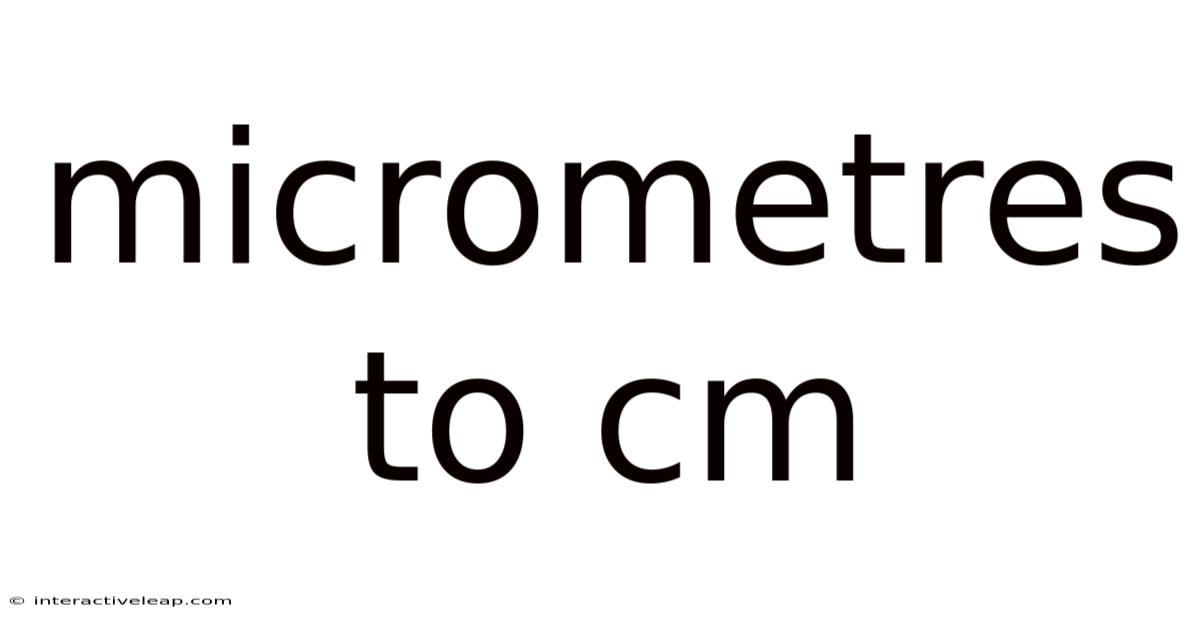Micrometres To Cm
interactiveleap
Sep 16, 2025 · 4 min read

Table of Contents
From Micrometers to Centimeters: A Comprehensive Guide to Unit Conversion
Understanding unit conversion is fundamental in many fields, from engineering and manufacturing to scientific research and everyday life. This comprehensive guide will delve into the conversion between micrometers (µm) and centimeters (cm), explaining the process, providing practical examples, and addressing common questions. Mastering this conversion will enhance your ability to work with measurements across different scales and improve your understanding of the metric system.
Introduction: Understanding Micrometers and Centimeters
The metric system, based on powers of 10, simplifies unit conversion. Micrometers (µm), also known as microns, are incredibly small units of length, representing one-millionth of a meter (1 µm = 10⁻⁶ m). They are commonly used to measure microscopic objects or features, such as cell sizes, wavelengths of light, or the thickness of thin films. Centimeters (cm), on the other hand, are a more macroscopic unit, representing one-hundredth of a meter (1 cm = 10⁻² m). Centimeters are frequently used for everyday measurements, such as the length of an object or the height of a person. The conversion between these two units involves understanding the relationship between powers of 10.
The Conversion Factor: Bridging the Gap
The key to converting micrometers to centimeters lies in understanding the conversion factor. Since there are 10,000 micrometers in one centimeter (1 cm = 10,000 µm), this becomes our crucial conversion factor. This means that every 10,000 micrometers is equivalent to 1 centimeter. This seemingly simple relationship is the foundation of all our subsequent calculations.
Step-by-Step Guide to Converting Micrometers to Centimeters
The conversion process is straightforward: divide the number of micrometers by 10,000 to obtain the equivalent value in centimeters. Let's break down the steps with examples:
Step 1: Identify the value in micrometers. Let's say we have a measurement of 50,000 micrometers (50,000 µm).
Step 2: Apply the conversion factor. We divide the value in micrometers by 10,000: 50,000 µm / 10,000 µm/cm = 5 cm.
Step 3: State the result. Therefore, 50,000 micrometers is equal to 5 centimeters.
Let's try another example: Convert 250 µm to centimeters.
Step 1: Value in micrometers: 250 µm
Step 2: Apply the conversion factor: 250 µm / 10,000 µm/cm = 0.025 cm
Step 3: Result: 250 micrometers is equal to 0.025 centimeters.
Working with Scientific Notation
For extremely large or small values, scientific notation is highly beneficial. Scientific notation expresses numbers as a product of a number between 1 and 10 and a power of 10. Let's convert 1.2 x 10⁷ µm to centimeters.
Step 1: Value in micrometers: 1.2 x 10⁷ µm
Step 2: Apply the conversion factor: (1.2 x 10⁷ µm) / (10⁴ µm/cm) = 1.2 x 10³ cm
Step 3: Result: 1.2 x 10⁷ micrometers is equal to 1.2 x 10³ centimeters (or 1200 cm). Notice how the exponent reduces by 4 (because we are dividing by 10⁴).
Practical Applications and Real-World Examples
The conversion between micrometers and centimeters finds application in diverse fields:
-
Manufacturing: Precision engineering often requires measurements in micrometers, particularly when dealing with tolerances in machining or creating micro-components. The resulting dimensions are then often expressed in centimeters for larger-scale assembly.
-
Materials Science: The thickness of thin films, coatings, or layers in materials science is often measured in micrometers. Understanding the equivalent centimeter value helps contextualize the scale.
-
Biology: Measuring the size of cells, organelles, or microscopic organisms often involves micrometers. Converting to centimeters provides a more relatable size comparison.
-
Optics: Wavelengths of light are typically expressed in micrometers or nanometers. Relating these to centimeters aids in understanding the scale of light wave phenomena.
Frequently Asked Questions (FAQs)
Q: Can I convert centimeters to micrometers?
A: Absolutely! To convert centimeters to micrometers, simply multiply the value in centimeters by 10,000. For example, 2 cm * 10,000 µm/cm = 20,000 µm.
Q: What if I have a measurement in millimeters?
A: To convert millimeters (mm) to centimeters, you divide by 10 (1 cm = 10 mm). To convert millimeters to micrometers, you multiply by 1000 (1 mm = 1000 µm). You can then use the methods described above to convert to centimeters.
Q: Are there online calculators for this conversion?
A: Yes, many online conversion calculators are available. These can be a helpful tool for quick conversions, but it's important to understand the underlying principles to avoid errors.
Q: Why is understanding this conversion important?
A: Understanding unit conversions, particularly between micrometers and centimeters, is crucial for accurate communication and calculations in various scientific and engineering fields. It helps bridge the gap between microscopic and macroscopic scales.
Conclusion: Mastering Micrometer to Centimeter Conversions
Converting micrometers to centimeters is a fundamental skill with broad applicability. By understanding the conversion factor (1 cm = 10,000 µm) and applying the appropriate mathematical operations, you can confidently navigate measurements across different scales. This skill is invaluable in various fields, from engineering and manufacturing to biology and materials science. Mastering this conversion enhances your problem-solving abilities and improves your comprehension of the metric system. Remember to always double-check your calculations and choose the appropriate method based on the context of your problem. With practice, this seemingly simple conversion will become second nature, allowing you to seamlessly work with measurements of varying magnitudes.
Latest Posts
Latest Posts
-
6 5 X
Sep 16, 2025
-
13 Times 13
Sep 16, 2025
-
0 48 In Fraction
Sep 16, 2025
-
74 6kg In Pounds
Sep 16, 2025
-
32cm Into Inches
Sep 16, 2025
Related Post
Thank you for visiting our website which covers about Micrometres To Cm . We hope the information provided has been useful to you. Feel free to contact us if you have any questions or need further assistance. See you next time and don't miss to bookmark.